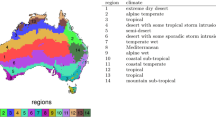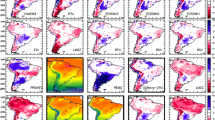Abstract
We present an analysis of a regional simulation of present-day climate (1981–1990) over southern South America. The regional model MM5 was nested within time-slice global atmospheric model experiments conducted by the HadAM3H model. We evaluate the capability of the model in simulating the observed climate with emphasis on low-level circulation patterns and surface variables, such as precipitation and surface air mean, maximum and minimum temperatures. The regional model performance was evaluated in terms of seasonal means, seasonal cycles, interannual variability and extreme events. Overall, the regional model is able to capture the main features of the observed mean surface climate over South America, its seasonal evolution and the regional detail due to topographic forcing. The observed regional patterns of surface air temperatures (mean, maxima and minima) are well reproduced. Biases are mostly within 3°C, temperature being overestimated over central Argentina and underestimated in mountainous regions during all seasons. Biases in northeastern Argentina and southeastern Brazil are positive during austral spring season and negative in other seasons. In general, maximum temperatures are better represented than minimum temperatures. Warm bias is larger during austral summer for maximum temperature and during austral winter for minimum temperature, mainly over central Argentina. The broad spatial pattern of precipitation and its seasonal evolution are well captured; however, the regional model overestimates the precipitation over the Andes region in all seasons and in southern Brazil during summer. Precipitation amounts are underestimated over the La Plata basin from fall to spring. Extremes of precipitation are better reproduced by the regional model compared with the driving model. Interannual variability is well reproduced too, but strongly regulated by boundary conditions, particularly during summer months. Overall, taking into account the quality of the simulation, we can conclude that the regional model is capable in reproducing the main regional patterns and seasonal cycle of surface variables. The present reference simulation constitutes the basis to examine the climate change simulations resulting from the A2 and B2 forcing scenarios which are being reported in a separate study.












Similar content being viewed by others
Abbreviations
- GCMs:
-
General circulation models
- RCMs:
-
Regional climate models
- LSM:
-
Land-surface model
- SST:
-
Sea surface temperature
- LLJ:
-
Low level jet
- DJF:
-
December–January–February
- JJA:
-
June–July–August
- SLP:
-
Sea level pressure
References
Caya D, Biner S (2004) Internal variability of RCM simulations over an annual cycle. Clim Dyn 22:33–46
Chen F, Dudhia J (2001) Coupling and advanced land surface-hydrology model with the Penn State-NCAR MM5 modeling system. Part I: model implementation and sensitivity. Mon Wea Rev 129:569–585
Christensen OB (1999) Relaxation of soil variables in a regional climate model. Tellus 51A:674–685
Dickinson R, Errico R, Giorgi F, Bates G (1989) A regional climate model for the western united states. Clim Change 15:383–422
Figueroa S, Satyamurti P, Silva Dias PL (1995) Simulation of the summer circulation over the South American region with an eta coordinate model. J Atmos Sci 52:1573–1584
Frei C, Christensen JH, Deque M, Jacob D, Jones RG, Vidale PL (2003) Daily precipitation statistics in regional climate models: evalution and intercomparison for the European Alps. J Geophys Res 108(D3):4124
Garand L (1983) Some improvements and complements to the infrared emissivity algorithm including a parameterization of the absorption in the continuum region. J Atmos Sci 40:230–244
Giorgi F (1990) On the simulation of regional climate using a limited area model nested in a general circulation model. J Climate 3:941–963
Giorgi F (2002) Dependence of surface climate interannual variability on spatial scale. Gephys Res Lett 29:2101, doi: 10.1029/2002GL016175
Giorgi F, Bi X, Pal J (2004) Mean, interannual variability and trends in a regional climate change experiment over Europe I. Present-day climate (1961–1990). Clim Dyn 22:733–756
Grell GA, Dudhia J, Stauffer DR (1993) A description of the fifth-generation Penn System/NCAR Mesoscale Model (MM5). NCAR Tech Note NCAR/TN−398+1A, 107 pp
Hong S, Pan H (1996) Non-local boundary layer vertical diffusion in a Medium-Range Forecast model. Mon Wea Rev 124:2322–2339
Hsie EY, Anthes RA, Keyser D (1984) Numerical simulation of frontogenesis in a moist atmosphere. J Atmos Sci 41:2581–2594
IPCC (2000) In: Nakicenovic N (Coordinating Lead Author). Emission scenarios, a special report of working group III of the intergovernmental on climate change. Cambridge University Press, Cambridge, p 599
Kain J, Fritsch J (1993) Convective parameterization for mesoscale models: The Kain-Fritsch scheme. In: Emanuell KA, Raymond DJ (eds) The representation of cumulus convection in numerical models. Amer Meteor Soc, Boston, pp 165–170
Kalnay E, et al (1996) The NCEP/NCAR 40-year reanalysis Project. Bull Am Meteorol Soc 77:437–471
Lenters JL, Cook KH (1995) Simulation and diagnosis of the regional South American precipitation climatology. J Climate 8:2988–3005
Leung LR, Qian Y, Bian X (2003) Hydroclimate of the western United States based on observations and regional climate simulation of 1981–2000. Part I: seasonal statistics. J Climate 16:1892–1911
Liang XZ, Li L, Kunkel K (2004) Regional climate model simulation of US precipitation during 1982–2002. Part I: annual cycle. J Climate 17:3510–3528
Liebmann B, Allured D (2005) Daily precipitation grids for South America. Bull Am Meteor Soc 86:1567–1570
Menéndez CG, Cabré MF, Solman SA, Nuñez MN (2003) Regional climate simulation over southern South America using MM5. In: 7th international conference on southern hemisphere meteorology and oceanography. Am Met Soc, Wellington, New Zealand, pp 59–61
Menéndez CG, Cabré MF, Nuñez MN (2004) Interannual and diurnal variability of January precipitation over subtropical South America simulated by regional climate model. Clivar Exchanges 29:1–3
Misra V, Dirmeyer PA, Kirtman BP, Juang HM, Kanamitsu M (2002) Regional simulation of interannual variability over South America. J Geophys Res 107(D20) doi: 10.1029/2001JD900216
Misra V, Dirmeyer PA, Kirtman BP (2003) Dynamic downscalling of seasonal simulations over South America. J Climate 16:103–117
Moberg A, Jones P (2004) Regional climate model simulations of daily maximum and minimum near-surface temperatures across Europe compared with observed station data 1961–1990. Clim Dyn 23:695–715
New MG, Hulme M, Jones PD (1999) Representing twentieth-century space time climate variability. Part I. Development of a 1961–1990 mean monthly terrestrial climatology. J Climate 12:829–856
New MG, Hulme M, Jones PD (2000) Representing twentieth-century space time climate variability. Part I. Development of a 1901–1996 mean monthly terrestrial climatology. J Climate 13:2217–2238
Nicolini M, Salio P, Katzfey J, McGregor JL, Saulo AC (2002) January and July regional climate simulation over South America. J Geophys Res 107(D20) doi: 10.1029/2001JD000736
Pal J, Eltahir E (2001) Pathways relating soil moisture conditions to future summer rainfall within a model of the land–atmosphere system. J Climate 14:1227–1242
Pope V, Gallani M, Rowntree P, Stratton R (2000) The impact of new physical parameterizations in the Hadley Centre Climate model. Clim Dyn 16:123–146
Räisänen J, Hansson U, Ullerstig A, Döscher R, Graham LP, Jones C, Meier HE, Samuelsson P, Willén U (2004) European climate in the late twenty-first century: regional simulations with two driving global models and two forcing scenarios. Clim Dyn 22:13–31
Rayner NA, Parker DE, Horton EB, Folland CK, Alexander LV, Rowell DP, Kent EC, Kaplan A (2003) Global analyses of SST, sea ice, and night marine air temperature since the late nineteenth century. J Geophys Res 108:4407 doi: 10.1029/2002JD002670
Reynolds RW, Rayner NA, Smith TM, Stokes DC, Wang W (2002) An improved in situ and satellite SST analysis for climate. J Climate 15:1609–1625
Rojas M, Seth A (2003) Simulation and sensitivity in a nested modeling system for South America. Part II: GCM boundary forcing. J Climate 16:2454–2471
Saulo AC, Nicolini M, Chou SC (2000) Model characterization of the South American low-level flow during the 1997–1998 spring-summer season. Clim Dyn 16:867–881
Seth A, Rojas M (2003) Simulation and sensitivity in a nested modeling system for South America. Part I. Reanalysis boundary forcing. J Climate 16:2437–2453
Stephens GL (1978) Radiation profiles in extended water clouds: II. Parameterization schemes. J Atmos Sci 35:2123–2132
Stephens GL (1984) The parameterization of radiation for numerical weather prediction and climate models. Mon Wea Rev 112:826–867
Tadross M, Gutowski W, Hewitson W, Jack C, New M (2006) Southern African interannual and diurnal climate variability in the MM5 regional climate model. Theor Appl Climatol 86:63–80
Wang M, Paegle J (1996) Impact of analysis uncertainty upon regional atmospheric moisture flux. J Geophys Res 101(D3):7291–7303
Xu H, Wang Y, Xie SP (2004) Effects of the Andes on Eastern Pacific Climate: a regional atmospheric model study. J Climate 17:589–602
Acknowledgments
This work was supported by the IAI Project CRN 055, UBACYT Grant 01-X072, ANPCYT Project PICT2002 12246 and partially by EU CLARIS Grant. We would like to thank the Hadley Centre for providing the HadAM3H data. The authors wish to thank to anonymous reviewers whose insightful comments and suggestions led to improve the manuscript. We also thank Alfredo Rolla for their invaluable cooperation in running the model.
Author information
Authors and Affiliations
Corresponding author
Rights and permissions
About this article
Cite this article
Solman, S.A., Nuñez, M.N. & Cabré, M.F. Regional climate change experiments over southern South America. I: present climate. Clim Dyn 30, 533–552 (2008). https://doi.org/10.1007/s00382-007-0304-3
Received:
Accepted:
Published:
Issue Date:
DOI: https://doi.org/10.1007/s00382-007-0304-3




